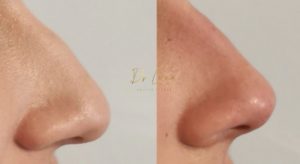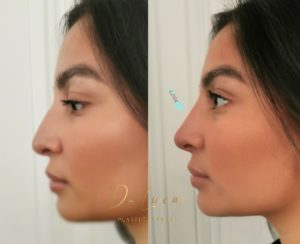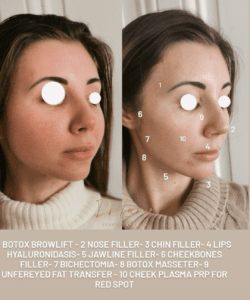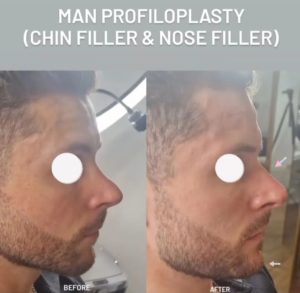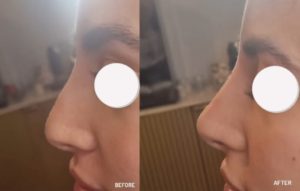Anatomy and ideal proportion :
The nose is a major element in the harmony of the face.
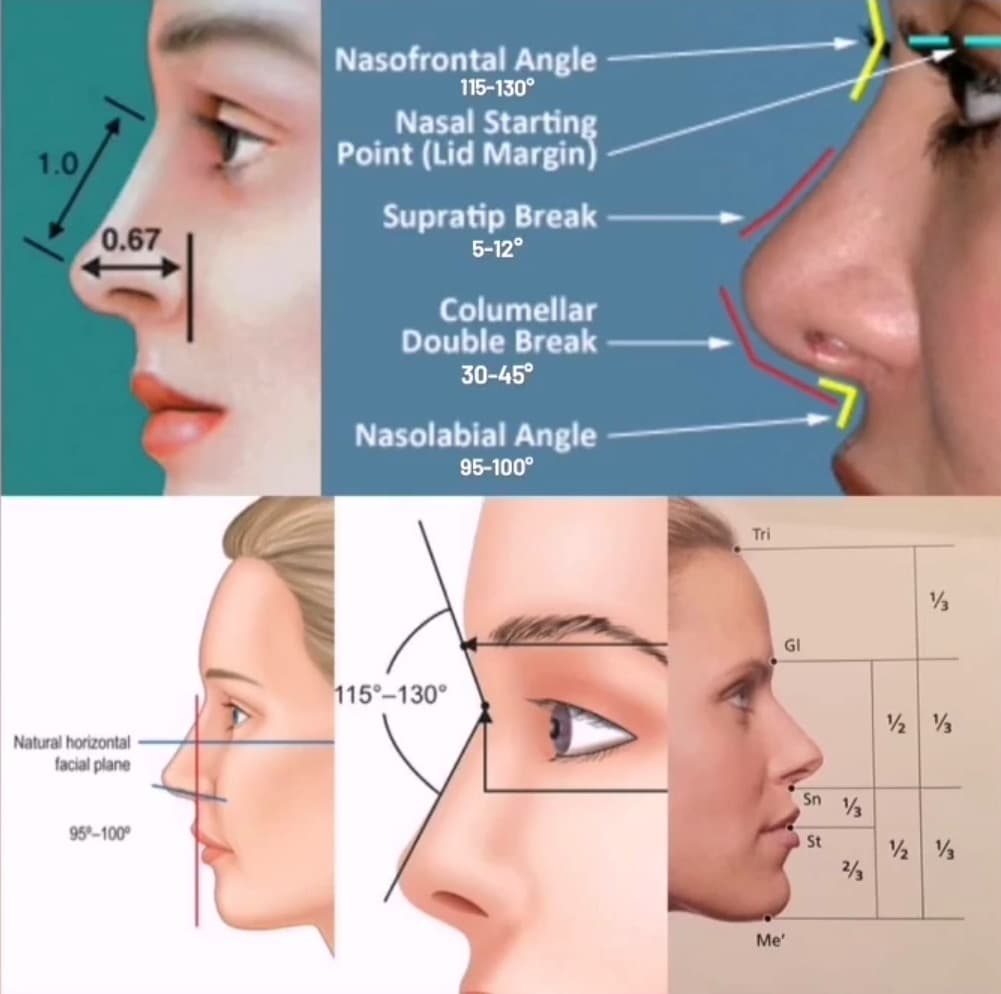
The ideal nose is defined by a multitude of artistic anatomical criteria: a projection/length ratio equal to 0.67, a naso-frontal angle (between the nose and the forehead) between 115 and 130° (close to 115° for men and closer to 130° for women: in fact, a nose with a more closed naso-frontal angle is a criterion of masculinity), a slight depression above the tip “supratip break” between 5 and 12° for women, an angulation below the tip “columellar double break” between 30 and 45°. Then, a naso-labial angle between 95 and 105° (closer to 95° for men and closer to 105° for women).
Artistically, the Sheen lines drawn by the natural shadows, start from the eyebrows, go down vertically along the nasal bridge and flare out at the tip. They must be harmonized during rhinoplasty.
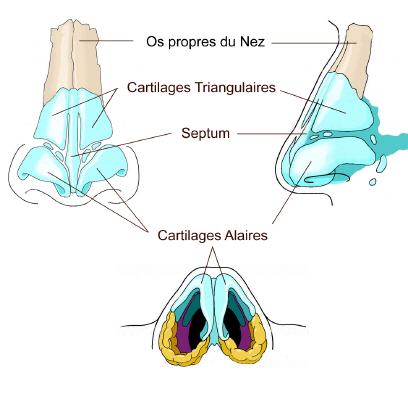
Anatomically, the nose has 3 levels:
- Upper: formed by the bones of the nose
- Middle: formed by the triangular cartilages
- Lower: formed by the alar cartilages, which are 2 rings placed one against the other, whose configuration defines the structure of the nostrils and the tip.
A nasal hump can concern only the upper level “bony hump” or the upper and middle levels “osteo-cartilaginous hump”.
Depending on the anatomical structure of your nose and in particular the structure of your cartilage, a rhinoplasty can sometimes be performed with hyaluronic acid, threads or a combination of both. A consultation with Dr. Lucas is necessary
Technique:
Hyaluronic acid:
Topical anesthesia with cream and filling with a cannula. The cannula, with its smooth, non-sharp tip, allows for a less painful injection with less bruising. We can inject the back of the nose to mask a bump or refine the dorsum, inject the base of the columella to open the nasolabial angle or inject the tip of the nose to refine it.
Threads:
These are inserted through micro-incisions (0.5 mm), run in tunnels under the skin to the root of the nose and the tension is adapted to raise the tip. The procedure is performed under local anesthesia, the entire tunnel is anesthetized for maximum patient comfort, the procedure takes 45 to 60 minutes. The tensor sutures are used to open the naso-labial angle, to correct a “columellar defilement”: hanging columella or to correct a discrete asymmetry.
Résultats :
Délai résultats définitifs :
Concernant l’acide hyaluronique, l’effet est immédiat.
Concernant les fils tenseurs : après une éviction sociale de 24-48h, on peut voir immédiatement le résultat avec une hypercorrection de quelques mm puis pour voir le résultat définitif il faut attendre 1 semaine environ.
Results:
Final results :
Concerning hyaluronic acid, the effect is immediate.
Concerning the tensor sutures: after a social eviction of 24-48h, one can see immediately the result with a hypercorrection of a few mm then to see the definitive result it is necessary to wait approximately 1 week.
Longevity of results :
Hyaluronic acid: 6 – 15 months
Tensor threads: 6 – 12 months
Before the procedure :
Stop smoking 1 month before surgery
Do not take Aspirin 10 days before surgery, inform Dr. Lucas of any anticoagulant medication (Sintrom, Coumadin, Eliquis, etc.) in order to arrange for its discontinuation or replacement.
Take Arnica capsules 5 times a day for 5 days before surgery to prevent hematoma.
Contraindications hyaluronic acid: autoimmune diseases, pregnancy, breastfeeding, former silicone injection on the same site
Procedure :
Pain: pain during the procedure will be almost non-existent, with an appropriate anesthesia
Duration of procedure: 60 minutes for each technique
Anesthesia: local
Location: office
Outpatient (without hospitalization)
After the procedure:
Post-operative pain: 1/10 often responding to Dafalgan
Social eviction :
Hyaluronic acid: no (sometimes swelling for a few days)
Tensor threads: 24-48h
Return to work: 1 – 2 days
Return to sports: 2 days for hyaluronic acid, 10 days after for the threads
Instructions:
Bed rest without major effort (which can cause the opening of small vessels during effort and lead to a hematoma) for 48 hours
Ice for 2-3 days, as often as possible, to reduce swelling
Take Arnica capsules 5 times a day for 5 days after surgery to prevent hematoma
Stop smoking for good to prolong the effect of the hyaluronic acid and the threads
Hyaluronic acid :
Avoid anti-inflammatory drugs and smoking for 48 hours
Massage areas the next day if you feel irregularities or hard areas for 1 week
Dr Lucas control 2 weeks, 3 months
Threads :
Preventive antibiotic Augmentin 1 g twice a day for 3 days after the operation
Avoid opening the mouth wide and movements that put the threads in traction for 1 week
Disinfection with spray twice a day for 3 days at the entry point of the thread.
Control Dr Lucas D7, 3 weeks, 3 months
Complications :
Hyaluronic acid:
– Infection, hematoma, asymmetry, under- or over-correction
– Intravascular injection: necrosis, blindness
Threads:
-Secondary displacement of the thread: the thread, if stimulated too hard during the 7 days following the procedure, may come off.
Nerve or vessel damage: the placement of tension wires must be performed by a doctor with a good knowledge of anatomy, with whom the risk of nerve damage is almost non-existent.
-Hematoma: there may be bruising, which generally disappears within 4 to 5 days maximum.
-Asymmetry
– Infection: often treated with antibiotics and local care. Exceptionally, it is necessary to remove the sutures when the infection is not controlled despite the preceding measures.
Alternative:
A consultation with a thorough clinical examination is necessary to determine if you can benefit from a rhinoplasty with hyaluronic acid or tensor threads or if surgery is more appropriate.

